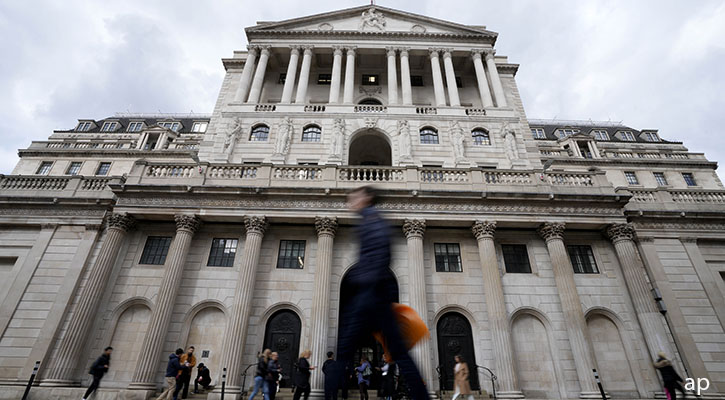
The Bank of England has been under immense pressure this year, and today's rate hike shows it is as busy as ever trying to keep a lid on inflation.
Amid all that this year, ruling politicians have questioned its remit and the cost-of-living crisis has been laid at its door. It’s also had to step in to prevent the implosion of one part of the UK pension industry. Staff probably won't look back fondly on the last 12 months.
But the Bank will remain under heavy scrutiny in 2023. What will make its job significantly easier is if inflation falls back, and there are tentative signs of that starting to happen, a trend seen already in the US.
The biggest question, not just for those fixing their mortgages, is if (and when) the Bank will stop its rate-hiking cycle? This is known as the "terminal rate" – and the assumption is that once the Bank has reached the top of that particular mountain, it will start the descent down the other side, easing monetary policy again after some big increases in 2022. Like the question that it’s linked to – has inflation peaked? – the answer depends on the data, which is moving all the time.
Let’s start with a recap. This time last year interest rates were 0.10%, a record low, and are now at 3.5% after nine interest rate rises. Going from 0.10% to 3.5% is significant in percentage terms, but that leaves rates below historical averages – the record high during another inflationary era was 17% in 1979.
While the era of cheap money may be over, anyone who depends on credit – a vast number of Britons, including companies big and small – will be hoping the Bank may be near the beginning of the end of the cycle after hiking continually in 2022.
Forwards contracts give investors an early insight into where financial markets expect rates to go next year - they are currently expecting a peak in rates above 4%. But at the last monetary policy committee meeting in November, the Bank’s Governor, Andrew Bailey, suggested that market prices may be too high, especially if inflation falls back quickly.
What Does Raising Rates Do?
Do interest rate increases contain inflation? It's both a serious academic question and one that urgently matters to households. Usually, making money more expensive curbs demand for goods and services and acts as brake on prices, prompting people to save more and spend less (getting better returns on cash deposits helps).
That's the theory at least, and probably a comfort to wannabe house buyers who want to see higher mortgages push down property prices. But raising interest rates makes no impact on people trying to fill up their cars or buying basics from the supermarket - you don't usually borrow money to buy petrol or bread and milk and prices for these are usually set by external factors. Food, energy and petrol are big components of inflation and the Bank's monthly changes don't usually move the dial on prices of these essentials.
We’ve discussed the limits of monetary policy in an article in May this year. Philip Shaw, chief economist at Investec, argues that because only 30% of the population has mortgages it's much harder to assess the impact of rates on households – and there's arguably less "transmission" to real economy and the effects are more uneven.
What the Experts Think
As you would expect, investment banks don’t agree on where the Bank’s terminal rate will be – and when it will occur, although there’s general agreement that the peak will be next year. (The caveat for these forecasts is that they were published before the December UK inflation data and the 15 December MPC meeting.)
Let’s start with the number itself: JP Morgan expects rates to hit 4.25% in the first quarter of 2023, but with a risk that sticky inflation could push rates higher: Goldman Sachs says just above 4%; Société Générale thinks rates could hit 4.5% next year but that the Bank of England could peak before the Federal Reserve because of the recent tax rises in the UK and the threat of an employment shock.
In terms of timing, UBS think the major central banks (US, UK, Eurozone and Switzerland) will end their hiking cycles in the first quarter of 2023 – or by the second quarter at the latest. But this is a base case scenario and depends on the data.
Analysts at Barclays think the Bank will stop hiking way before the markets are expecting; but that the terminal rate of 3.5% will stay at that level until 2024. Then the Bank could cut rates twice, back to 3%. But this assumes that inflation pressure will have eased by then. (Barclays expects CPI to remain above 8% for 2023.) Nevertheless, wage growth inflation could force the Bank to keep hiking rates into next year, Barclays warns.
Earlier this year, Bank Governor Bailey warned workers not to demand pay rises in case it fuelled what economists fear above all – a "wage price spiral", where higher pay triggers higher inflation, which then leads to higher wage demands.
Bailey, paid roughly £500,000 a year, was at the time criticised for misjudging the public mood. But the idea has resurfaced recently amid a spate of strikes affecting the railways, postal services and the NHS. For his part, chancellor Jeremy Hunt recently warned unions their wage demands risked embedding inflation and threatening any nascent recovery.
A Threat Then an Olive Branch
Sticking with politics, it’s worth noting the "journey" that Threadneedle Street has been on this year. Liz Truss, a prime minister of just 44 days, took the top job after threatening to look again at the Bank’s independence, which has been protected for 25 years. The Bank saw off that threat and the year ended with chancellor Hunt affirming its remit. He insisted at the Autumn Statement that the central bank and government are working in unison.
One closing observation: it’s often hard for outsiders to grasp what the Bank means and what it intends to do. If you want to know exactly what the base rate will be a year from now because you’re playing fixed-rate mortgage roulette, you may be disappointed.
As we discovered during "forward guidance" in the Mark Carney era, the Bank’s forecasts are couched in a range of caveats (and jargon) and are subject to change. Even the experts can’t predict where interest rates will be next year; a range of probable scenarios is the closest you’re likely to get. If 2022 has taught us anything (the pandemic and Brexit too), forecasting is fraught with difficulty as the variables keep changing. Still, one thing has remained constant even as inflation has soared: the Bank insists that it will be falling back to the 2% target in "the medium term". Let's hope it's right.








.jpg)



















